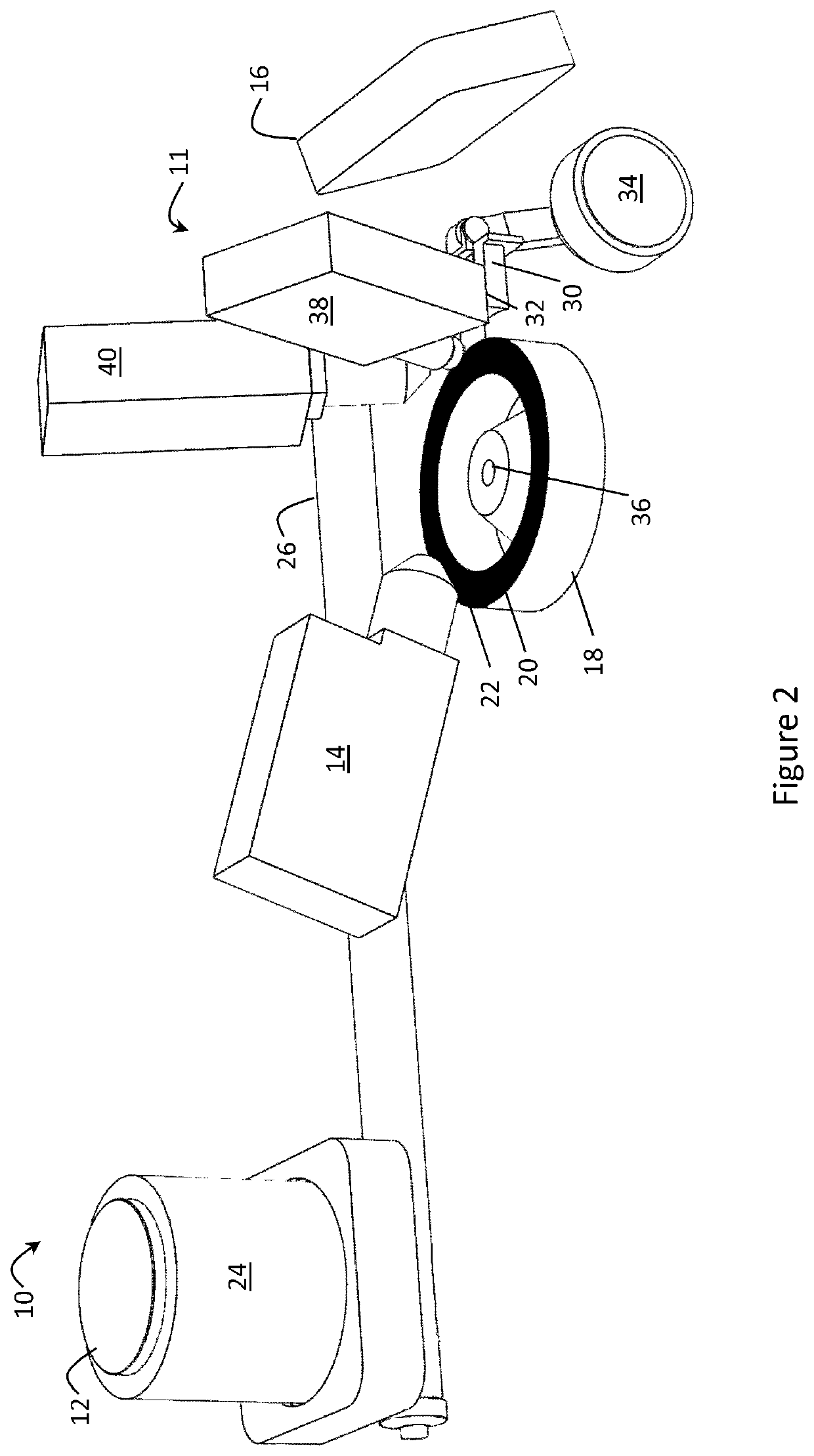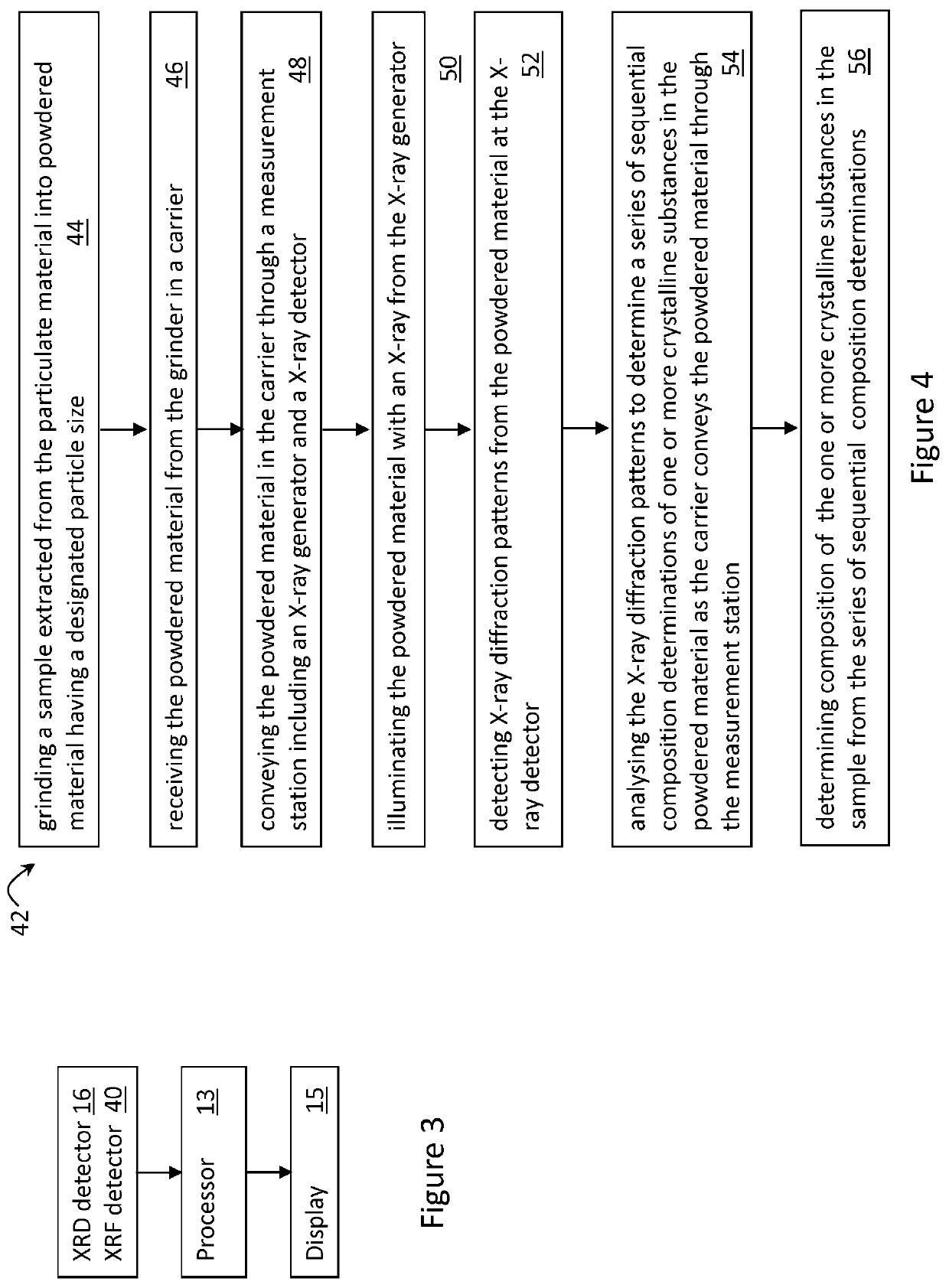[0011]In an embodiment, the grinder allows relatively coarse particulate material (e.g. up to 14 mm diameter) to be ground into a sufficiently fine powder for the apparatus to analyse the material. The grinder enables the removal of several steps of user interaction with the sample that are described above (e.g. fine grinding and preparing the powdered sample) with respect to the prior art example of a spectral analyser; thereby increasing precision and accuracy of the apparatus. For example, the designated particle size from the grinder has 30% of particles less than 45 μm. The coarser particle size from the grinder, than say the prior art example of 5 μm, is enabled by the carrier conveying a much larger volume of powdered material through the measuring station to determine a series of composition determinations of the powdered material rather than just determining a composition determination of a small static volume of powdered material. In the example, the volume of the powdered material in the above mentioned prior art example is ˜1 cm3 and the volume of powdered material conveyed through the measuring station is ˜150 cm3.
[0014]In an embodiment, the processor is configured to receive the X-ray diffraction pattern of the standard material and compare the diffraction pattern of the standard material with an expected diffraction pattern of the standard material to determine a scale factor corresponding to at least in part a flux value of the X-ray generator. The processor is then configured to apply the scale factor to the series of sequential composition determinations of crystalline substances to determine a calibrated composition of the one or more crystalline substances in the sample. It will be appreciated by those persons skilled in the art that X-ray tubes reduce their flux with operational time due to various factors such as tungsten deposition, loss of vacuum, environmental temperature or partial filament failure. This flux can be correlated with the scale factor from the determined and the expected patterns, and is used as compensation for the tube flux variation over time to calibrate and maintain accuracy of the apparatus. Thus, by applying the scale factor, the accuracy of the composition determinations by XRD of the one or more crystalline substances in the sample is improved.
[0020]In an embodiment, the plate is disposed on an actuator configured to move the standard material on the plate between a first position in the measurement station and a second positon not in the measurement station. The actuator is further configured to move the standard material into the measurement station before and / or after the carrier conveys the powdered material through the measurement station. That is, in this embodiment, the scale factor is determined with each determination of the composition of crystalline substances in the sample, to compensate for the X-ray source flux to improve the quality of the analysis.
[0023]Preferably, the roller includes a heating element to heat the roller to a designated temperature. The heating of the roller ensures that ‘sticky’ powdered material does not become a problem by attaching itself to the roller. If small amounts of material do attach to the roller it would result in an uneven or patchy upper surface of the powdered material in the groove, providing a poor bed for analysis and inaccurate results. The heating element enables the roller to be heated to a material dependent temperature. For example, for cement product, this temperature is around 90° C. The heated roller is speed matched to the speed of rotation of the turntable and the taper allows for no speed differential between the inner and outer tracks of the groove; thus providing a very smooth and flat surface of powdered material to be presented to the X-ray beam. In a further embodiment, the roller is curved to impart a slight curvature to the sample bed in the groove which aids in focusing the X-ray beams for XRD.
[0024]As mentioned, the rotating turntable is used to significantly increase the volume of sample that is being analysed from the above mentioned prior art static sample analyser. Hence, the number of diffraction conditions that are going to be experienced by particles in the sample is also increased. The traditional XRD systems described above use a sample plate with around 1 cm3 of material and rely heavily on sample preparation to achieve reliable results. The apparatus, however, uses a much larger sample volume of around 150 times, which provides significant advantage such as better sample representation, greater number of diffraction conditions and less single particle effects which are averaged out over a large number of analysed X-ray diffraction patterns. By using a larger volume of powdered sample material for analysis, there is a much higher number of crystallites that line up in the X-ray beam producing diffracted beams, as per Braggs's Law (2d sin θ=nλ). The higher number of detected diffracted beams allow for a significant reduction (e.g. 10×) in X-ray power requirements and the relaxation of the requirement for a very fine particle size.
[0033]In another embodiment, the apparatus is arranged to improve results of the analysis of the material by reducing instances of the detector detecting scattered X-ray beams from the sample and the standard material, by using an anti-scatter disc disposed at the centre of the turntable.
 Login to View More
Login to View More 


